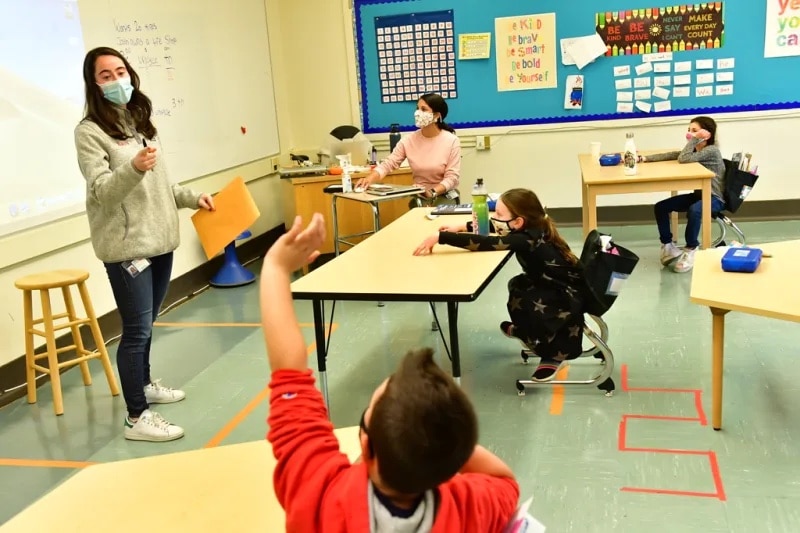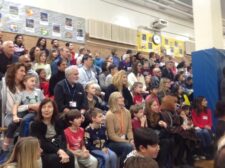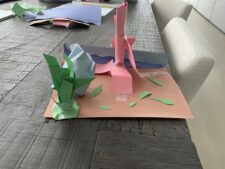“Hello, hello! I’m so happy to see you all! It’s like we’re all together!” 2nd Grade Teacher Monique Astengo-Rosen grins on camera. Her 2nd Grade class waves back at her, and Astengo-Rosen announces that today’s class — the Wednesday after Election Day, during which ballots are still being counted across the country — will be a general discussion of elections and voting.
I know that there are a lot of emotions about this election, and sometimes those emotions are very strong in us, and that’s okay. What’s important is what we do with those feelings inside of us.
First, she sets some community norms. The conversation will not be about which candidate is better or worse, she says. “I know that there are a lot of emotions about this election, and sometimes those emotions are very strong in us, and that’s okay. What’s important is what we do with those feelings inside of us.” The class nods along as she continues. “I want to be sure that our conversation is respectful. We’re going to listen to others. This is a listening discussion.”
She reminds the students of the first class rule: that they “insist on kindness.” One other request: that students keep the conversation to themselves instead of sharing their classmates’ opinions with friends. It’s a way to create a moment of trust — a feeling that’s critical to discussions about the election in any Fieldston Lower classroom.
“What’s an election?” Astengo-Rosen asks. Leo B. ’31 is the first to raise his hand.
“An election is a time when you vote for something. If two people want salad and three people want spaghetti, you take a vote. That’s an election.”
Eva M. ’31 adds her take: “Thank you for sharing that, Leo. I think that an election is a special day when you get to make your voice be heard.”
Astengo-Rosen continues with questions: What is voting? What is a ballot? Why does someone need an absentee ballot? The students pipe up with their answers, thanking each other for sharing their viewpoints.
The conversation ranges: Students volunteer more examples of voting in their daily lives, discuss the higher rates of mail-in ballots due to the pandemic, and deliberate different methods of voting. (“Hands raised and eyes closed” and “writing your answer on a piece of paper and putting it in a bowl with other answers” are popular methods.)
Once they’ve dispensed with how to vote, the students tackle a thornier topic: winning and losing. 2nd Grade Teacher Sydney Beres ’14 poses a hypothetical scenario concerning a poll of favorite ice cream flavors: “What if chocolate wins and you really wanted vanilla? How might you feel?” The students chime in with emotions: sad, mad, frustrated. “And how would you feel if what you voted for wins?” she asks. The answer is a uniform “happy” from the 2nd Graders.
They turn this over, the idea that they might come out of an election feeling negative — or that their friends may have different reactions. “People in your classroom and the world have different opinions,” Beres says. “How do we act as a community if that happens?”
The students have answers. Milani P. ’31 says, “Not cheering. Don’t do anything to make the people feel sad that their vote didn’t win.”
London B. ’31 adds: “You can just say ‘yay’ in your head and give your hand a little high-five.”
Cora S. ’31 has a plan for consoling upset classmates: “Say, ‘Maybe next time your vote will win.’”
At Fieldston Lower, the faculty approach an election cycle as they do any extracurricular event: by meeting the students where they are. “We always try to take an inquiry approach,” says Fieldston Lower Principal Joe McCauley, “and we want the students’ questions to guide their learning and understanding of the topic.” This starts with an open-ended conversation in which students share what they know and voice their points of confusion. Teachers correct misinformation and host follow-up conversations based on student questions.
Teachers also aim to strike a calm and neutral tone — even when the topic is challenging or emotional for many adults. “Children often mirror the various emotions that surround them, and it is important to be mindful of what we say, what we share, and how we process in front of our children because they are often tuning in even when we least expect them to be,” says Dr. Simira Freeman, Fieldston Lower School Psychologist. While they may have strong personal beliefs, teachers focus on letting their students develop and express their own opinions. It was common in classes this fall to hold elections on nonpolitical issues: schoolwide issues, for example, or opinion polls about favorite animals or colors.
We lean into fraught conversations: an upsetting news event, or a racial injustice, or a school shooting. Whatever it is, our students will bring it up, and we’ll have those conversations.
The faculty at Fieldston Lower are honest with the students, opting to present the world in an age-appropriate manner without sugarcoating it. “We know the students are aware of what’s going on around them,” McCauley says, reiterating the need to let students lead the conversation. The students are used to grappling with difficult concepts. “We lean into fraught conversations: an upsetting news event, or a racial injustice, or a school shooting. Whatever it is, our students will bring it up, and we’ll have those conversations.”
In keeping with ECFS’s whole-child approach to education, the faculty at Fieldston Lower keep in mind the social-emotional component of teaching the election cycle. Reactions range widely based on age and level of exposure to the political climate. “Oftentimes, not fully understanding and having inaccurate information can be a source of anxiety for children,” Freeman says. “Leading up to the elections, the faculty at Fieldston Lower were very thoughtful about how they explained the process and the role of voting and elections in our country.”
Demystifying sometimes-opaque processes quells tension and satiates a thirst for understanding. “Children are always eager to learn about the social systems around them,” Freeman says.
In the 5th Grade classroom of Dani Cardia ’07, an overview of the United States’ electoral processes quickly evolves into a critical unpacking of the country’s history.
“I’m not sure if you’re aware, but there’s a presidential election this week. Did anyone know that?” Cardia asks. Hands shoot up in the classroom and on screens; everyone is keyed in to what’s going on. In keeping with the spirit of inquiry, Cardia asks if anyone knows what the Electoral College is.
“Each state gets electoral votes based on how many people they have,” Madelyn A. ’28 says. “California has the most people, so it gets 55 votes. You need 270 votes.”
Good so far. “Most states have a winner-take-all approach,” continues Cardia. “Do you know the exceptions?”
“There’s Maine and Nebraska,” Matias K. ’28 says. “I think that’s a better way, and they should do that in all states.”
And here’s where the conversation progresses to another level of complexity. “Does anyone know what institution that this country was founded on led to this system?” Cardia asks. “It’s an important part of our history, and an upsetting part of our history.”
In the Google Meet’s chat window, the students make a guess: slavery. Cardia explains how the Electoral College was in fact enacted to uphold the enslavement of hundreds of thousands of people brought to the United States against their will. When she gets to the Three-fifths Compromise, the students are outraged.
“PaRdOn mE?!” Olivia S. ’28 puts in the chat. “3/5?!”
“WRONG! JUST WRONG,” types Phoebe H. ’28.
As a follow-up to their discussion, Cardia has her 5th Graders play an online game that allows them to demonstrate their understanding by both answering factual questions and sharing their opinions anonymously. At the end of the game, the students must indicate to what extent they agree or disagree with a final question: “I believe the Electoral College is the fairest way to elect a president.”
It’s an opportunity for students to take in new information and synthesize it with their own values to form opinions. The class doesn’t shy away from nuance, and the students fall all over the spectrum, with a strong concentration in the middle.
Laura Stewart, 5th Grade Teacher, runs a morning group for remote students. She starts with a morning poll: What’s our favorite new Google feature? Which is better: apple juice or orange juice? For all the adult-centered stress children may be aware of, kids are still kids who are concerned with homework, seeing friends, and their favorite flavor of juice.
But their lessons in equity provide a lens for their experiences. Take, for example, a morning poll in the weeks leading up to the election. Noticing that one student was eating string cheese during their meeting, a student suggested a poll of how the children eat string cheese: by pulling off strings or taking bites. Students pushed back: What if you don’t eat string cheese either way? What if you’re lactose-intolerant? “So, the question became: ‘How do we word the poll so that everyone can be reflected?’” Stewart says.
The students understand that voting should include everyone and recognize that this is painfully not the case. In areas where they have power, they are committed to doing better and forging a more inclusive path forward.
Fieldston Lower’s approach to teaching the election — like all newsworthy events — is one that focuses on creating upstanders, not bystanders: students who will take an active role in their communities. From the basic knowledge of what a ballot is in students’ younger years to discussions of inequity in voting as students get older, Fieldston Lower students wrestle with some of the biggest issues of our time. Their education makes clear in age-appropriate ways the ideals and injustices of the American electoral system, and the students are energized to work toward a more just world — one that lives up to their values and ideals.



